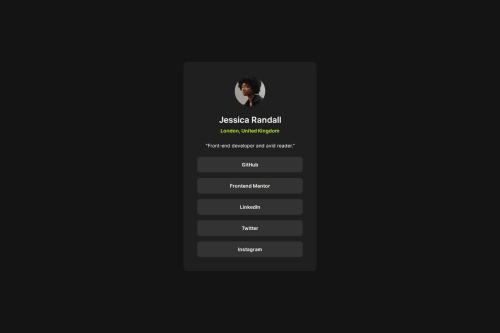Social Profile Links Card using HTML/CSS

Solution retrospective
I'm proud of the fact that I am getting faster at doing these challenges
What challenges did you encounter, and how did you overcome them?I struggled with centering stuff.. again 😂
What specific areas of your project would you like help with?I would like to know if I am doing things in a way that is using best practices.
Please log in to post a comment
Log in with GitHubCommunity feedback
- P@danielmrz-dev
Hello there!
Congrats on completing the challenge! ✅
Your solution looks great!
📌 It's recommended to use semantic HTML elements like
<ul>and<li>for creating lists. This ensures that your code is more accessible, maintainable, and semantically meaningful.Here's and example on how you can refactor your code:
After Refactoring
<ul class="list-container"> <li><a href="#">Github</a></li> <li><a href="#">Frontend Mentor</a></li> <li><a href="#">LinkedIn</a></li> ... </ul>By using
<ul>and<li>, you convey the structure of your content more clearly, making it easier for screen readers and search engines to understand. Additionally, it aligns with best practices for HTML semantics.I hope you find this helpful!
Keep up the excellent work!
- P@rupali317
Hello @timdogan0
I am in agreement with @danielmrz-dev's suggestions.
Additionally, I have a few pointers that can enhance the structure and accessibility of your code:
-
Your project is missing a
<h1>. Instead of<h2>you should use<h1>. Headings facilitate page navigation for users of many assistive technologies. They also provide semantic and visual meaning and structure to the document. A first level heading<h1>should be present on nearly all pages. It should contain the most important heading on the page (generally the document title). -
For the "Front-end developer and avid reader", instead of
<p>you can use the quote tag<q>as it is more appropriate as a quote.
I suggest you use WAVE, Accessibility insights to test how your project is doing in terms of accessibility.
Let me know if this helps.
-
Join our Discord community
Join thousands of Frontend Mentor community members taking the challenges, sharing resources, helping each other, and chatting about all things front-end!
Join our Discord